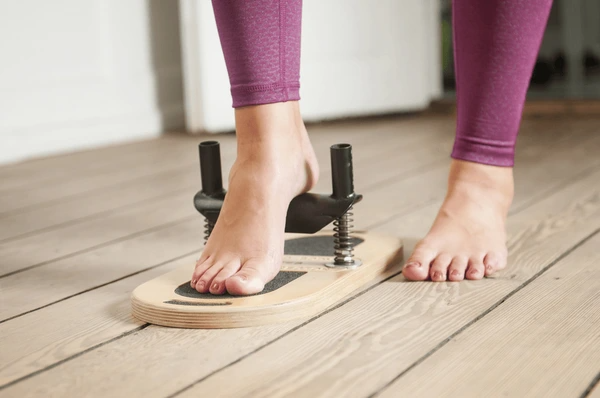When you think about flexibility, one word that instantly pops into your mind is gymnastics. You can see the control a gymnast has over every flip, twist and split. Thanks to the flexibility that makes this possible, every move is more fluid and breathtaking.
In reality, can't we all be flexible? Though we need not necessarily be gymnasts, at least can we be flexible to some extent?
Being flexible doesn't just mean having the ability to touch your toes or do a split. When you are flexible, everyday activities such as bending down to pick something up or even sitting at your desk become more comfortable and less straining.
Pilates exercises have proven to be a great way to achieve this kind of flexibility. Because while performing these exercises, you focus on stretching and strengthening your muscles simultaneously.
With regular Pilates practice, you not only get more flexible but also build a stronger and more resilient body.
This article talks about the importance of flexibility and how Pilates exercises using simple Pilates equipment help you achieve gymnastic skills like flexibility. Now let’s get started.
What is Pilates flexibility?
Pilates flexibility is about the improved range of motion and ease of movement that you gain from practicing Pilates.
It's all about stretching and lengthening your muscles while also strengthening them. Unlike most workout routines that focus purely on muscle building, Pilates is designed to make your body both strong and flexible. So, the exercises in Pilates work on your flexibility by targeting the muscles around your joints. This makes it easy for you to bend, stretch and twist without any discomfort or risk of injury.
Often, people confuse mobility with flexibility. Flexibility refers to your muscles and other connective tissues's ability to stretch temporarily.
Mobility is the ability of your joints to move freely through a range of motion without any strain or pain.
Find the best Pilates equipment in Brisbane. Check out our exclusive collections.
Pilates flexibility vs. yoga flexibility
When people aim to improve their flexibility, they often have to choose between yoga and Pilates. Though they are both highly effective, they approach it in their own unique ways.
Pilates focuses mainly on dynamic movements that build strength alongside flexibility, particularly in the core. This creates a balanced body with enhanced control.
Meanwhile, yoga is about static stretching, mindfulness and breathwork that promote deep, holistic flexibility that nurtures mental calm and balance.
Pilates mobility exercises
This type of exercise focuses on core stability exercises that enhance how your joints move. This not only boosts your body awareness but also increases your range of motion.
Pilates equipment flexibility
Pilates equipment such as the Reformer, Wunda Chair and Cadillac helps enhance flexibility by offering resistance and support that help you stretch deeper and move more smoothly.
This equipment also targets specific muscle groups in your body and makes it easy to increase flexibility while also maintaining control and stability.
Pilates for strength and flexibility
While yoga aims to improve your body's stretching, Pilates focuses on improving strength while also increasing flexibility.
Mindful movement
In yoga, mindful movement is about connecting breath with each pose. It helps an individual focus on being present in the moment and hold stretches to deepen the connection between body and mind.
On the other hand, Pilates mindful movement is also about doing controlled, precise exercises that engage the core.
Benefits of increasing flexibility with Pilates exercises are:
Adding Pilates stretches to your routine can make you feel stronger, more relaxed and able to do your daily tasks more easily. But that’s not all; the other benefits are:
Better posture
When your muscles become more flexible, it's easier to stand tall and keep your spine in alignment. So no slouching, no back pain and no dealing with complications due to poor posture.
Reduce muscle tension
If you have tight muscles, you have discomfort and stiffness. Stretching them out regularly via Pilates can help release that tension. This makes you feel more relaxed and comfortable.
Improved range of motion
When you start performing Pilates exercises, moving becomes easier for you. This way, flexibility increases as your body feels more fluid and less restricted.
Lowers the risk of injury
When your muscles are flexible, they are less prone to strains and injuries. So, you can stretch and move without worrying about moving. This keeps you injury-free, too.
Boosted performance
Flexibility makes everything smoother. So, whether you hit the gym, play any sports, or simply perform your daily tasks, you can do them without much strain.
Increase blood flow
Stretching gets the blood pumping in your body, right? This helps your muscles bounce back faster and keeps you feeling fresh and healthy, too.
Looking for Pilates equipment in Perth? Explore our range of premium gear to enhance your practice.
What are some Pilates exercises to improve flexibility?
If your target is to boost your body's flexibility, rest assured that Pilates has got your back. There are several exercises that not only help you stretch but also build strength and control at the same time.
The Corkscrew
This exercise can boost the mobility of your hips and spine and strengthen your core.
To perform this exercise,
- Lie on your back and stretch your legs towards the ceiling.
- Place your arms by your sides.
- Inhale as you circle your legs to one side while also lifting your hips slightly off the floor.
- Exhale as you complete the circle and bring your legs back to the centre.
- Repeat this exercise in the opposite direction.
But it's not recommended for people dealing with osteoporosis. If you have this, modify this exercise a bit. Keep the hips on the mat with the legs just circling.
The Bicycle
Like the previous one, this pilates also focuses on improving your hips, hamstrings, and knees and also strengthens your core.
To perform this exercise,
- Lie flat on your back on your floor and take a deep breath in.
- Next, while your whole body is in a rest position, use your hands to support your pelvis and lift it up a bit.
- Bring your legs on a high diagonal, let the legs reach the ceiling and bend the knees in towards your chest.
- Next, lower your leg straight to the mat and simultaneously, bend the opposite knee towards your chest.
- Now cycle the legs 5 to 10 times, alternatively. Perform the same exercise in the reverse direction.
The Scissors
This exercise is great for stretching and strengthening the hamstrings and hip flexors. It not only improves flexibility in your legs but also engages your core muscles for stability.
To perform this exercise,
- Start by lying on your back with your legs and placing your arms by your side.
- Pull both knees in towards your chest, then lift your spine up to make your legs reach straight out, parallel to the floor.
- Next, keep your knees slightly bent as you bring them back in towards your chest. Place your hands high on your back for support.
- Reach both legs to the ceiling. Lower one straight leg to the mat as you bring the opposite straight leg towards your chest. Gently pull the top leg towards you twice, then switch to the other leg.
The Saw
This is another best pilates for gymnasts and literally anyone who is looking to stretch and loosen up with tight muscles, especially in your legs and back. So, you can bend and stretch like a pro. It's also great for getting your spine to move more freely.
To perform this exercise,
- Sit straight with your legs stretched straight. Now, widen your legs apart with your feet flexed.
- Now stretch your arms straight to the sides at shoulder height.
- With your hands stretched on both sides, rotate your torso to the right. Next, exhale and try touching the right foot with your left hand.
- Now, again, inhale and move your spine, staying in rotation. Exhale and turn to the centre.
- Keep repeating the same on the other side.
While performing this Pilates exercise, ensure your lower body is fixed to the mat.
Safety tips for pilates flexibility
- Warm up before you do Pilates exercises. Because jumping straight into deep stretches can make you uncomfortable. So, get your body to perform some light warm-ups to get your muscles ready. Try going for a walk, jog or swim before you start.
- It's crucial to perform exercises with the right technique. Pay attention to how your body is positioned and how you breathe while you stretch. This focus helps you avoid pushing yourself too far and possibly getting hurt.
- Start slow. Don't try or aim to touch your toes on the first day itself. This exercise needs patience. So, start with easy steps and give your body time to adjust.
- Breathing is important while performing Pilates exercises for flexibility. Holding your breath can make things tense up a bit.
- Listen to what your body is trying to say. While trying any Pilates exercise, if you don't feel right, back off. Because this exercise is about having control and taking things slowly. So, don't push yourself through pain.
- Ensure that your core muscles are engaged. This helps reduce the risk of straining or injuring your lower back.
Final Words
There's no doubt that Pilates exercises can do wonders for improving your body's flexibility. When compared to yoga, Pilates lets you modify your practice based on your pace and fitness level. The best advantage here is that to improve flexibility using Pilates, you don't have to invest in big Pilates equipment. You just have to need simple pieces of equipment, such as a mat, a set of hand weights and some resistance bands, to adjust or control the movements.
But many question: How long does it take to see results from Pilates flexibility? Firstly, every person is unique and we can't predict this.
However, if you are consistently performing Pilates 2 to 3 times a week to improve flexibility, you will start noticing some improvements in a few weeks. So, it's all about steady progress.
You can find top-quality Pilates equipment in Australia that will take your workout to the next level. Shop now to find everything you need for a full-body workout!





Share:
A Guide to Pilates Equipment for Seniors to Enhance Health and Well-being
Elevate Your Fitness Routine with the Pilates Ring: Key Benefits and Exercise